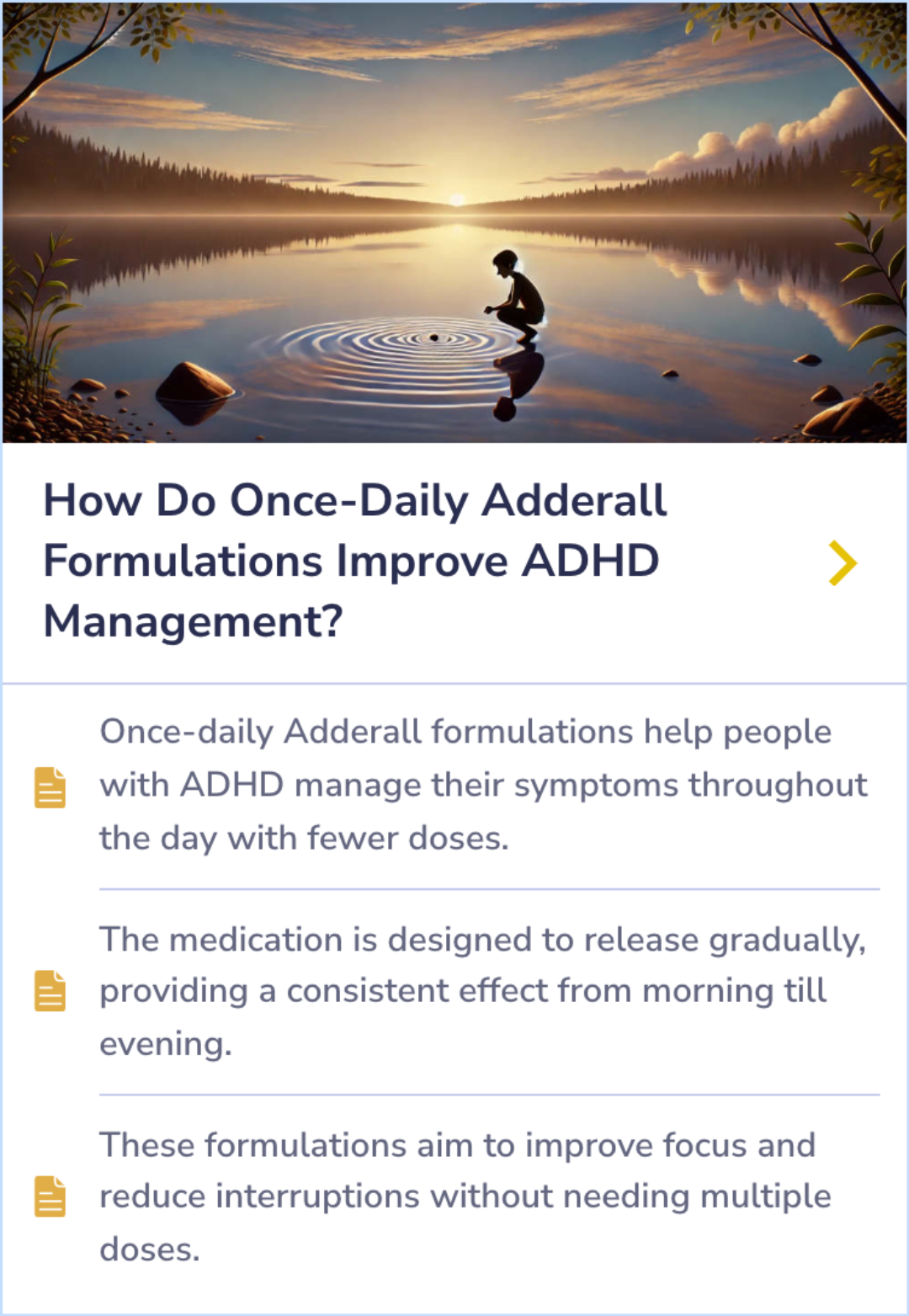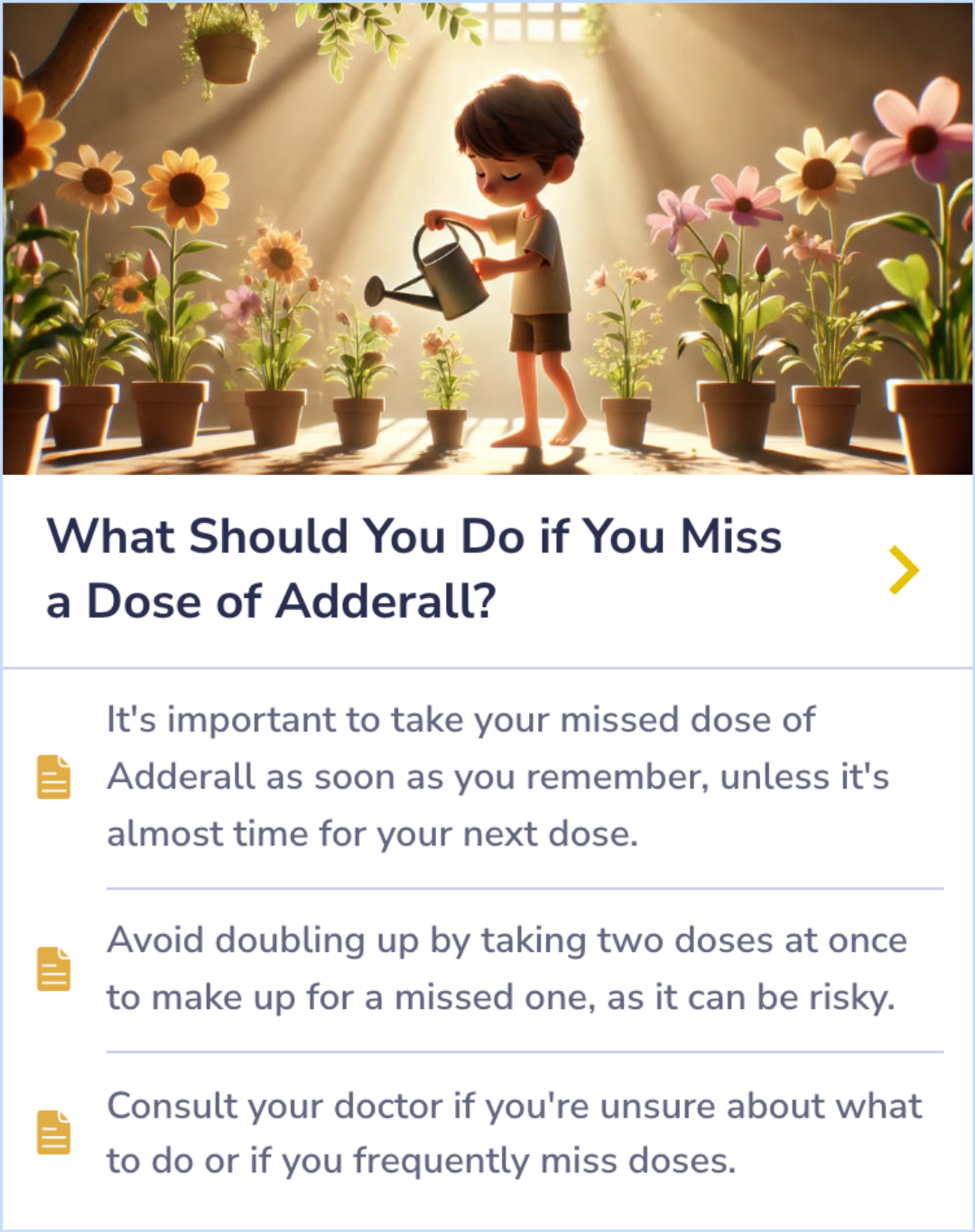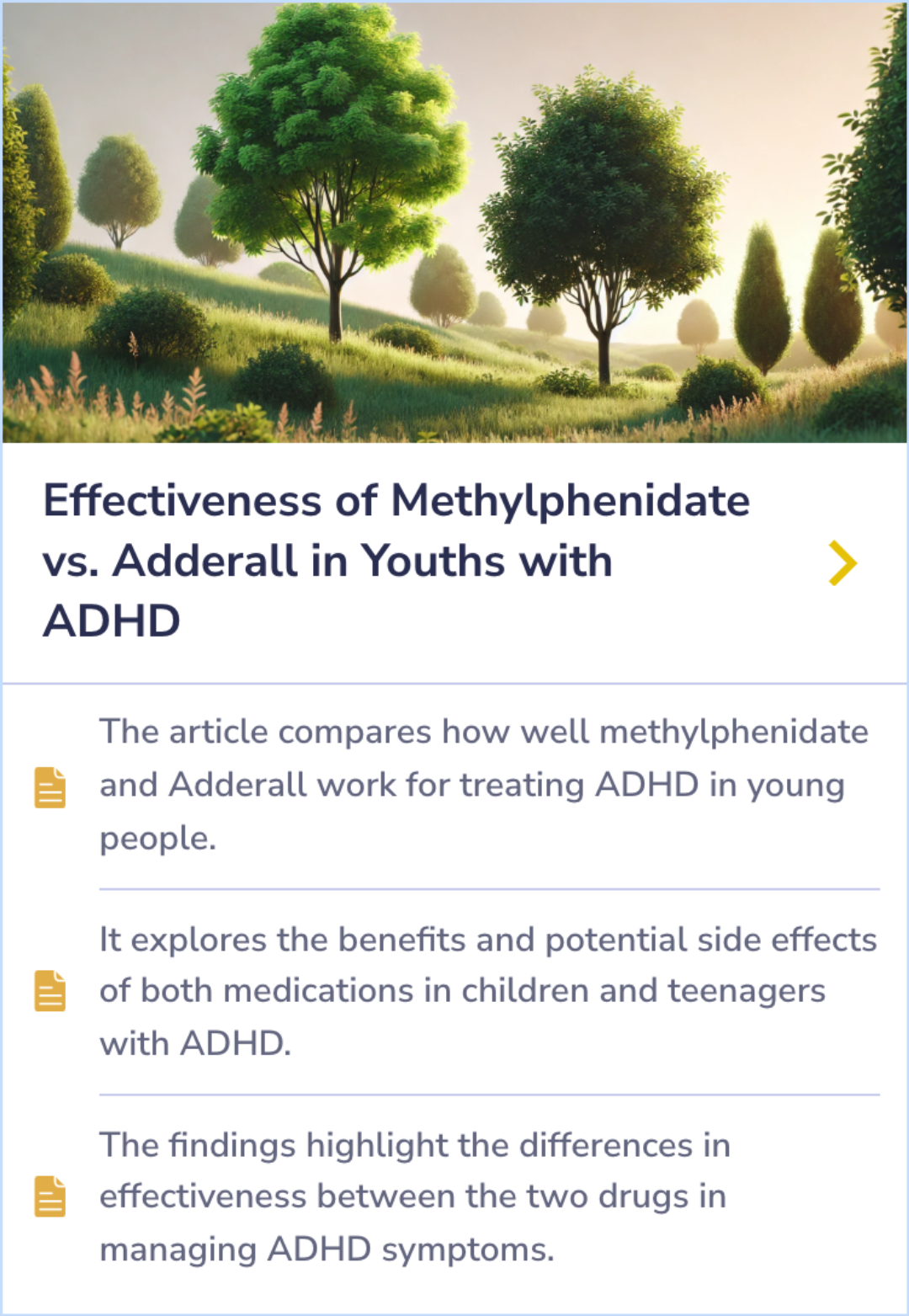Adderall
Evidence Based Answers
Adderall Drug Forms and Ingredients
Adderall combines dextroamphetamine and amphetamine to treat ADHD by enhancing focus. Available in various forms, it offers immediate-release flexibility or extended-release lasting effects. Inactive ingredients aid in safe and stable delivery.
Published: November 11, 2024
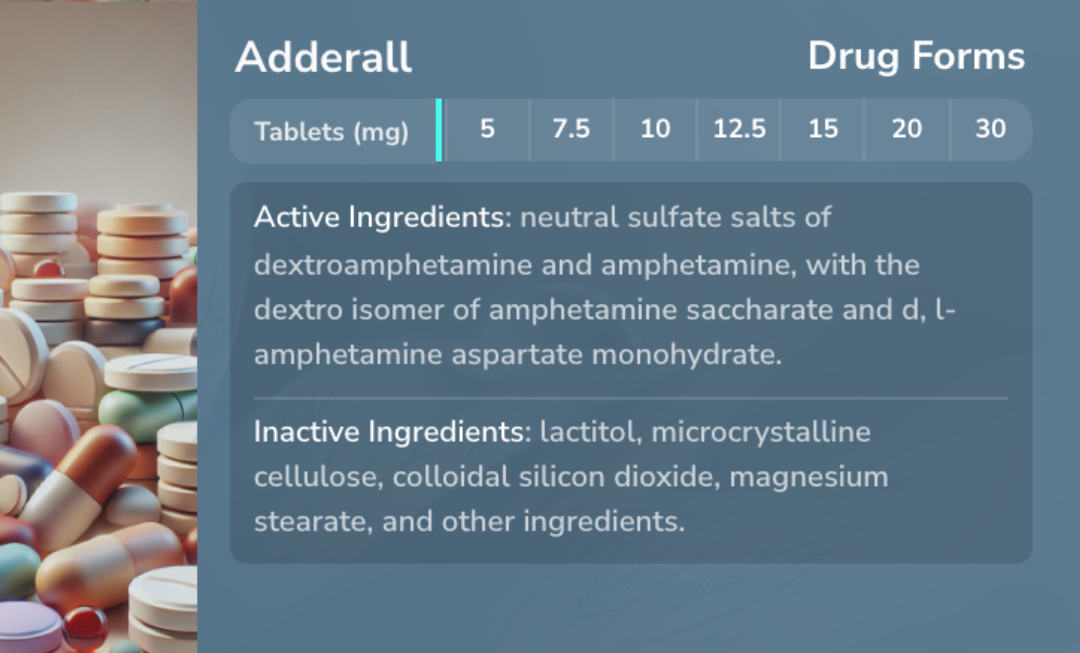
Adderall uses dextroamphetamine for ADHD, available in IR and XR, inactive ingredients ensure stability.
Active Ingredients in Adderall
Adderall contains two main active ingredients: dextroamphetamine and amphetamine. These ingredients are mixed as salts, with dextroamphetamine being more potent for treating ADHD symptoms. They stimulate the central nervous system, enhancing focus and reducing hyperactivity.
The amphetamine molecule exists in two forms: dextroamphetamine and levoamphetamine. Adderall primarily uses the dextro form due to its higher effectiveness for ADHD treatment.
The amphetamine molecule exists in two forms: dextroamphetamine and levoamphetamine. Adderall primarily uses the dextro form due to its higher effectiveness for ADHD treatment.
“
Source Quotes:
Adderall is a single-entity amphetamine product combining the neutral sulfate salts of dextroamphetamine and amphetamine, with the dextro isomer of amphetamine saccharate and d, l-amphetamine aspartate monohydrate.
The amphetamine molecule contains one chiral center and exists as two enantiomers: dextroamphetamine (d-amphetamine) and levoamphetamine (l-amphetamine). The term 'amphetamine' properly refers to a racemic mixture of equal parts d-amphetamine and l-amphetamine.
Adderall Dosage Options
Adderall is available in different forms to meet individual needs. Immediate-release (IR) tablets are typically taken 2-3 times daily, while extended-release (XR) capsules are taken once in the morning. Strengths range from 5 mg to 30 mg. Some versions use color additives like FD&C Blue #1 or Yellow #6 for identification.
Immediate-release tablets offer dosing flexibility, while extended-release capsules provide longer-lasting effects, reducing the number of doses per day.
Immediate-release tablets offer dosing flexibility, while extended-release capsules provide longer-lasting effects, reducing the number of doses per day.
“
Source Quotes:
Adderall® 5 mg is a white to off-white tablet, which contains no color additives. Adderall ® 7.5 mg and 10 mg contain FD&C Blue #1. Adderall ® 12.5 mg, 15 mg, 20 mg and 30 mg contain FD&C Yellow #6 as a color additive.
Common amphetamine medications that are currently in use in the United States include: Dextroamphetamine/amphetamine, a 3 to 1 mixture of d-amphetamine and l-amphetamine salts, otherwise known as mixed amphetamine salts (MAS).
Immediate-Release vs. Extended-Release Adderall
Adderall comes in immediate-release (IR) and extended-release (XR) forms. IR tablets are taken multiple times a day, while XR capsules are taken once daily in the morning to provide consistent symptom control.
Extended-release formulations ensure gradual medication release, helping maintain stable ADHD symptom management throughout the day. The choice between IR and XR forms depends on personal preferences and treatment needs.
Extended-release formulations ensure gradual medication release, helping maintain stable ADHD symptom management throughout the day. The choice between IR and XR forms depends on personal preferences and treatment needs.
“
Source Quotes:
The combination of dextroamphetamine and amphetamine comes as an immediate-release tablet (Adderall) and as an extended-release (long-acting) capsule (Adderall XR, Mydayis) to take by mouth.
The extended-release capsule (Mydayis) is usually taken upon awakening and must be taken consistently either with or without food.
Inactive Ingredients in Adderall
Adderall also contains inactive ingredients like lactitol, microcrystalline cellulose, and magnesium stearate. These components help form the tablet or capsule and aid in absorption and stability. Though they do not directly contribute to Adderall's effects, they ensure safety and consistency.
Different formulations may have unique inactive ingredients, so patients should check for potential allergens or sensitivities.
Different formulations may have unique inactive ingredients, so patients should check for potential allergens or sensitivities.
“
Source Quotes:
Inactive Ingredients: lactitol, microcrystalline cellulose, colloidal silicon dioxide, magnesium stearate, and other ingredients.
Ask your pharmacist for a list of the ingredients. The medication in each product is absorbed differently by the body, so one dextroamphetamine and amphetamine product cannot be substituted for another product.
Key Takeaways
Conclusions
Adderall combines dextroamphetamine and amphetamine to boost focus and curb hyperactivity by stimulating the central nervous system. The dextro form is favored for its enhanced effectiveness.
Options like immediate-release and extended-release forms cater to diverse treatment needs, offering flexibility or sustained relief. Inactive ingredients ensure formulation safety and stability, with some unique to specific versions.
Options like immediate-release and extended-release forms cater to diverse treatment needs, offering flexibility or sustained relief. Inactive ingredients ensure formulation safety and stability, with some unique to specific versions.
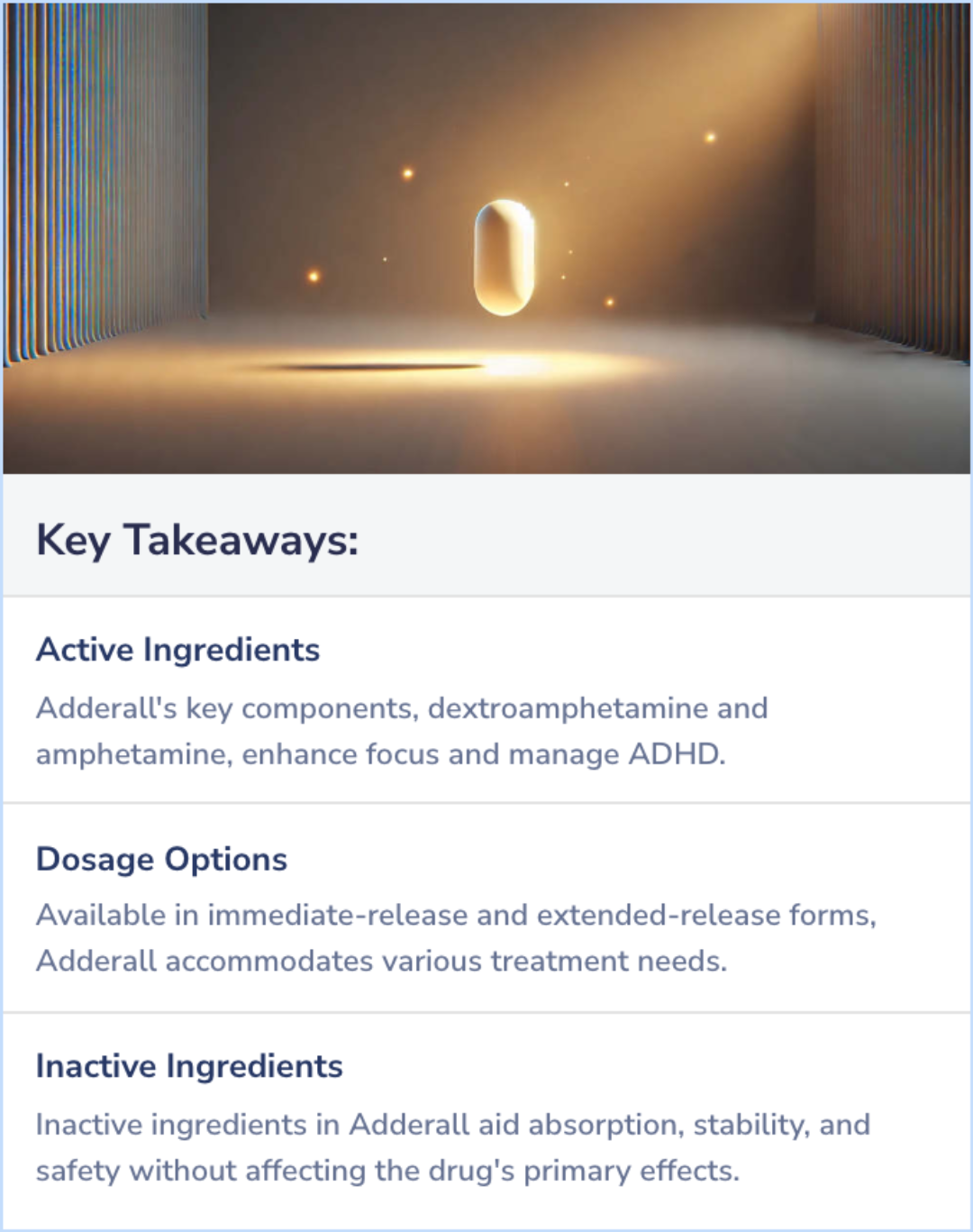
Evidence Summary
Consistent Focus with Once-Daily Adderall
Once-daily Adderall formulations offer a steady release of medication, helping individuals with ADHD stay focused without needing multiple doses. By spreading out the release, these formulations support consistent symptom control from morning to evening.
Reducing the need for frequent dosing helps minimize interruptions and enhances overall focus, allowing individuals to better manage their daily tasks and routines.
Reducing the need for frequent dosing helps minimize interruptions and enhances overall focus, allowing individuals to better manage their daily tasks and routines.
Evidence Summary
Managing Missed Doses of Adderall Safely
If you miss a dose of Adderall, take it as soon as possible, unless your next dose is approaching. Doubling up doses to make up for a missed one can lead to risks and should be avoided. Always talk to your doctor if you're uncertain about what to do or if missing doses becomes frequent.
Taking a missed dose too close to your next one may cause unwanted side effects. It's best to seek medical advice if you're unsure about adjusting your schedule.
Taking a missed dose too close to your next one may cause unwanted side effects. It's best to seek medical advice if you're unsure about adjusting your schedule.
Evidence Summary
Methylphenidate vs. Adderall: ADHD Treatment Comparison
Comparing two widely used ADHD medications, this article sheds light on the differences between methylphenidate and Adderall in treating young people. It examines how each drug manages ADHD symptoms in children and teens, revealing unique aspects of their effectiveness.
The study highlights the benefits and potential side effects associated with each medication, helping distinguish which might suit different patients and treatment goals.
By analyzing both drugs, the study provides a clearer picture of their roles in ADHD management for youth.
The study highlights the benefits and potential side effects associated with each medication, helping distinguish which might suit different patients and treatment goals.
By analyzing both drugs, the study provides a clearer picture of their roles in ADHD management for youth.
